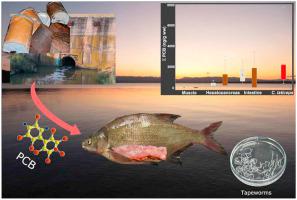Environmental Pollution ( IF 8.9 ) Pub Date : 2021-09-13 , DOI: 10.1016/j.envpol.2021.118175 Tímea Brázová 1 , Dana Miklisová 1 , Daniel Barčák 1 , Dalibor Uhrovič 1 , Peter Šalamún 1 , Martina Orosová 1 , Mikuláš Oros 1

|
The present paper reports on the interrelationships of fish, parasites and the bioaccumulation of hazardous organic compounds in the Zemplínska Šírava water reservoir in eastern Slovakia, which is heavily polluted with polychlorinated biphenyls (PCBs). The concentrations of these contaminants were measured in various fish matrices (dorsal and abdominal muscle tissues, hepatopancreas, intestine wall and adipose tissue) of the freshwater bream, Abramis brama (Cyprinidae), and in its intestinal parasite Caryophyllaeus laticeps (Cestoda), which was used for the first time as a model for a PCB bioaccumulation study. Regarding the fish, the highest concentrations of PCBs were found in the intestine, followed by hepatopancreas and muscle tissues. The amounts of PCBs were higher in abdominal muscles than in their dorsal parts. Concentrations of ∑PCBs above the limits set by European regulations were detected in both muscle parts in the fish, confirming the persistent unfavorable conditions in this locality and high risk for biota and humans. Based on bioconcentration factor values (BCFs), PCBs reached much higher levels in cestodes compared to bream matrices. Some significant differences in PCB amounts between infected and uninfected bream were determined. Fulton's condition factor (CF) significantly differed in infected and non-infected fish (p ˂ 0.05), with CF values surprisingly lower in fish free of parasites compared to parasitized fish, which suggests a “mutualistic” relationship between the parasite and its host.
中文翻译:

环境中的有害污染物:鱼类宿主-寄生虫相互作用和多氯联苯的生物积累
本文件报告了斯洛伐克东部 Zemplínska Šírava 水库中鱼类、寄生虫和有害有机化合物的生物积累之间的相互关系,该水库受到多氯联苯 (PCB) 的严重污染。这些污染物的浓度的淡水鲷,各种鱼矩阵(背侧和腹部肌肉组织,肝胰腺,肠壁和脂肪组织)进行测量欧鳊(鲤科),并在其肠寄生虫Caryophyllaeus laticeps(Cestoda),它首次被用作 PCB 生物积累研究的模型。就鱼类而言,在肠道中发现的 PCB 浓度最高,其次是肝胰腺和肌肉组织。腹肌中PCBs的含量高于背部肌肉。在鱼的两个肌肉部位都检测到 ∑PCB 的浓度高于欧洲法规规定的限值,证实了该地区持续的不利条件以及对生物群和人类的高风险。根据生物浓度因子值 (BCF),与鲷鱼基质相比,多氯联苯在绦虫中的含量要高得多。确定了受感染和未受感染的鲷鱼之间 PCB 数量的一些显着差异。富尔顿条件因子 (CF) 在感染和未感染鱼中显着不同 (p ˂ 0.05),


























 京公网安备 11010802027423号
京公网安备 11010802027423号